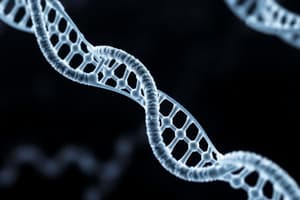Podcast
Questions and Answers
Which term best describes the concept that physical traits are passed from parents to offspring due to genetic inheritance?
Which term best describes the concept that physical traits are passed from parents to offspring due to genetic inheritance?
- Adaptive radiation
- Genetic inheritance (correct)
- Phenotypic variation
- Natural selection
What type of bonds are crucial in forming proteins and are created during the process of dehydration synthesis?
What type of bonds are crucial in forming proteins and are created during the process of dehydration synthesis?
- Disulfide bonds
- Peptide bonds (correct)
- Hydrogen bonds
- Ionic bonds
Which level of biological organization includes both communities and populations?
Which level of biological organization includes both communities and populations?
- Biome
- Organism
- Ecosystem (correct)
- Biosphere
Which process is associated with breaking down polymers into monomers through the addition of water?
Which process is associated with breaking down polymers into monomers through the addition of water?
Which group of organisms is characterized by the presence of membrane-bound organelles?
Which group of organisms is characterized by the presence of membrane-bound organelles?
What is formed when pairs of valence electrons are shared between two atoms?
What is formed when pairs of valence electrons are shared between two atoms?
What type of bond occurs due to the attraction between two oppositely charged ions?
What type of bond occurs due to the attraction between two oppositely charged ions?
When the proton number and electron number are unequal, what term describes the atom or molecule?
When the proton number and electron number are unequal, what term describes the atom or molecule?
Which of the following statements about the components of a nucleotide is FALSE?
Which of the following statements about the components of a nucleotide is FALSE?
How many covalent bonds can a Carbon atom typically form?
How many covalent bonds can a Carbon atom typically form?
What type of macromolecule are enzymes primarily classified as?
What type of macromolecule are enzymes primarily classified as?
Which of the following correctly describes the difference between unsaturated and saturated fats?
Which of the following correctly describes the difference between unsaturated and saturated fats?
Which pair of nitrogenous bases in DNA is held together by two hydrogen bonds?
Which pair of nitrogenous bases in DNA is held together by two hydrogen bonds?
Which part of an amino acid's basic structure determines its unique functional characteristics?
Which part of an amino acid's basic structure determines its unique functional characteristics?
Which of the following correctly identifies the primary functions of lipids?
Which of the following correctly identifies the primary functions of lipids?
In nucleotides, which part is responsible for the vast variation among different organisms?
In nucleotides, which part is responsible for the vast variation among different organisms?
Which structure is primarily involved in synthesizing proteins that may be exported from the cell?
Which structure is primarily involved in synthesizing proteins that may be exported from the cell?
What would be the consequence if lysosomes ceased to function correctly?
What would be the consequence if lysosomes ceased to function correctly?
Which of the following contains the 9 + 2 arrangement of microtubules?
Which of the following contains the 9 + 2 arrangement of microtubules?
What is indicated by large numbers of ribosomes in a cell?
What is indicated by large numbers of ribosomes in a cell?
Which organelle is known to have its own DNA and ribosomes?
Which organelle is known to have its own DNA and ribosomes?
What is the main purpose of the scientific method?
What is the main purpose of the scientific method?
Which of the following structures is NOT part of a prokaryotic cell?
Which of the following structures is NOT part of a prokaryotic cell?
Which term refers to the arrangement of various components within a cell membrane?
Which term refers to the arrangement of various components within a cell membrane?
Which type of bonding occurs when electrons are shared between atoms?
Which type of bonding occurs when electrons are shared between atoms?
What is characteristic of hypotonic solutions?
What is characteristic of hypotonic solutions?
What distinguishes eukaryotic cells from prokaryotic cells?
What distinguishes eukaryotic cells from prokaryotic cells?
What is facilitated diffusion?
What is facilitated diffusion?
Which of the following is a component of the endomembrane system?
Which of the following is a component of the endomembrane system?
What is the primary role of ribosomes?
What is the primary role of ribosomes?
Which process does NOT require energy?
Which process does NOT require energy?
What does the term 'selective permeability' refer to?
What does the term 'selective permeability' refer to?
How do ion bonds differ from covalent bonds?
How do ion bonds differ from covalent bonds?
What is the characteristic feature of the cytosol?
What is the characteristic feature of the cytosol?
What is the sequence proteins follow for processing and export from the cell?
What is the sequence proteins follow for processing and export from the cell?
Which of the following correctly describes the structure of a phospholipid in the plasma membrane?
Which of the following correctly describes the structure of a phospholipid in the plasma membrane?
What process describes the movement of molecules from high concentration to low concentration through a selectively permeable membrane?
What process describes the movement of molecules from high concentration to low concentration through a selectively permeable membrane?
Which of the following is NOT a part of the sodium-potassium pump mechanism?
Which of the following is NOT a part of the sodium-potassium pump mechanism?
Adjacent cells can communicate through direct contact and nearby cells communicate via what mechanisms?
Adjacent cells can communicate through direct contact and nearby cells communicate via what mechanisms?
What describes the process of taking in large amounts of material by a cell?
What describes the process of taking in large amounts of material by a cell?
Which of the following substances cannot easily pass through the cell membrane?
Which of the following substances cannot easily pass through the cell membrane?
Which cytoskeletal component is described as the 'highway' for intracellular transport?
Which cytoskeletal component is described as the 'highway' for intracellular transport?
Flashcards
What is biology?
What is biology?
The study of life and living organisms. It includes everything from the smallest microorganisms to the largest ecosystems.
What is DNA?
What is DNA?
The hereditary material found in all known organisms. It carries the genetic information that determines an organism's traits.
What is an atom?
What is an atom?
The smallest unit of an element that retains the chemical properties of that element.
What is a molecule?
What is a molecule?
Signup and view all the flashcards
What is a cell?
What is a cell?
Signup and view all the flashcards
What is a tissue?
What is a tissue?
Signup and view all the flashcards
What is an organ?
What is an organ?
Signup and view all the flashcards
What is an organ system?
What is an organ system?
Signup and view all the flashcards
What is an organism?
What is an organism?
Signup and view all the flashcards
What is a population?
What is a population?
Signup and view all the flashcards
What is a community?
What is a community?
Signup and view all the flashcards
What is an ecosystem?
What is an ecosystem?
Signup and view all the flashcards
What is the biosphere?
What is the biosphere?
Signup and view all the flashcards
What is genomics?
What is genomics?
Signup and view all the flashcards
What is proteomics?
What is proteomics?
Signup and view all the flashcards
What are analogous structures?
What are analogous structures?
Signup and view all the flashcards
What are homologous structures?
What are homologous structures?
Signup and view all the flashcards
What is natural selection?
What is natural selection?
Signup and view all the flashcards
What are covalent bonds?
What are covalent bonds?
Signup and view all the flashcards
What are polar covalent bonds?
What are polar covalent bonds?
Signup and view all the flashcards
What are hydrogen bonds?
What are hydrogen bonds?
Signup and view all the flashcards
What are essential elements for life?
What are essential elements for life?
Signup and view all the flashcards
What are isotopes?
What are isotopes?
Signup and view all the flashcards
What are macromolecules?
What are macromolecules?
Signup and view all the flashcards
What are carbohydrates?
What are carbohydrates?
Signup and view all the flashcards
What are proteins?
What are proteins?
Signup and view all the flashcards
What are nucleic acids?
What are nucleic acids?
Signup and view all the flashcards
What are lipids?
What are lipids?
Signup and view all the flashcards
What are eukaryotic cells?
What are eukaryotic cells?
Signup and view all the flashcards
What are prokaryotic cells?
What are prokaryotic cells?
Signup and view all the flashcards
What is the nucleus?
What is the nucleus?
Signup and view all the flashcards
What are ribosomes?
What are ribosomes?
Signup and view all the flashcards
What are mitochondria?
What are mitochondria?
Signup and view all the flashcards
What are lysosomes?
What are lysosomes?
Signup and view all the flashcards
What is the endosymbiotic theory?
What is the endosymbiotic theory?
Signup and view all the flashcards
Study Notes
Chapter 1: Foundations of Biology
- Biology is the study of life and living organisms.
- DNA is the hereditary material in all known organisms.
- Biological organization levels: atoms, molecules, cells, tissues, organs, systems, organisms, populations, communities, ecosystems, biosphere.
- Genomics focuses on the study of all genes, while proteomics looks at all proteins produced.
- Analogous structures arise from convergent evolution, while homologous structures derive from common ancestry.
- Charles Darwin formulated the theory of natural selection based on evolutionary principles.
Chapter 2: Chemical Context of Life
- Atoms with incomplete valence shells engage in bonding by sharing or transferring electrons.
- Covalent bonds form when pairs of valence electrons are shared between atoms.
- Polar covalent bonds involve unequal sharing of electrons, and hydrogen bonds occur between polar molecules.
- Essential elements for life include carbon, hydrogen, nitrogen, oxygen, phosphorus, and sulfur.
- Isotopes have the same number of protons but differ in neutrons, affecting atomic mass.
- Molecules consist of covalent bonds, with electronegativity influencing bond formation.
Chapter 3: Macromolecules
- Four main macromolecules: carbohydrates, proteins, nucleic acids, and lipids.
- Carbohydrates serve for energy storage and structural support; examples include sugars and starch.
- Proteins function in catalysis, transport, and structural roles; made of amino acids linked via peptide bonds.
- Nucleic acids store and transmit genetic information; composed of nucleotides (consisting of a sugar, phosphate group, and nitrogenous base).
- Lipids include fats, oils, phospholipids, and steroids, crucial for energy storage and membrane structure.
Chapter 4: Cell Structure and Function
- Eukaryotic cells have membrane-bound organelles, while prokaryotic cells lack a nucleus and organelles.
- Key organelles: nucleus (houses genetic material), ribosomes (protein synthesis), mitochondria (energy production), and lysosomes (digestion).
- The endosymbiotic theory suggests eukaryotic cells evolved from symbiotic relationships between prokaryotes.
- Cell membranes possess selective permeability, allowing transport via diffusion, osmosis, and active transport.
- The fluid mosaic model describes the structure of cell membranes with embedded proteins and phospholipids.
Chapter 5: Cell Signaling
- Cell signaling can occur via direct contact or through release of signaling molecules, such as hormones.
- The phospholipid bilayer is composed of hydrophilic heads and hydrophobic tails, forming a barrier to certain molecules.
- Functions of the plasma membrane include protection, transport regulation, signal reception, and cell recognition.
- Diffusion involves movement from areas of high to low concentration, driven by kinetic energy.
- Active transport requires energy to move substances against concentration gradients, exemplified by the sodium-potassium pump.
Additional Key Concepts
- Tonicity environments: hypotonic (cell gains water), hypertonic (cell loses water), isotonic (cell remains balanced).
- Hydrolytic enzymes are present in lysosomes, crucial for breaking down waste materials.
- The "highway" of the cytoskeleton involves microtubules essential for intracellular transport.
- Ribosomes are abundant in cells that synthesize large amounts of protein.
Studying That Suits You
Use AI to generate personalized quizzes and flashcards to suit your learning preferences.
Description
Prepare for your BSC 2010 Exam 1 with this comprehensive review worksheet. It covers key concepts from Chapter 1 and Chapter 3, including essential biology terms and functional groups. Perfect for reinforcing your understanding of DNA, polymers, and monomers.




